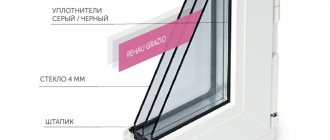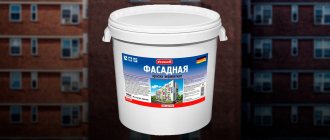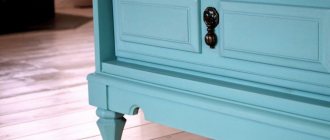Usually people purchase and install plastic double-glazed windows with a white frame color.
But there are times when you need to change the color of the frame. The consumer is faced with a natural question: what to do in this case - change the double-glazed windows or repaint the frame.
Replacing a window is a costly procedure and not always justified, so you can simply paint the window the desired color. Are plastic windows painted and how to do it correctly - read on.
Is it possible to paint plastic window structures?
Changing the color of plastic windows can at the same time be called a bold and original decision, the adoption of which requires from the owner of the room in which such transformations are planned not only the desire to change “something”, but also the emergence of a number of specific reasons and, of course, time for the competent organization of everything process. At the same time, such a procedure has a number of positive and negative sides, which you should definitely get acquainted with even before you purchase the necessary materials and begin to implement your plan.
Reasons for repainting windows
The need to change the color of plastic windows may be necessary in a number of cases:
- yellowing or the appearance of a gray tint on the windows after some time of use, and as a result, any scratches and mechanical damage become visually noticeable on the surface of the frame;
- painting plastic windows will be the most rational solution in a situation where a white window does not fit into the interior of the room after renovation, and installing a new double-glazed window in the near future is not included in the owners’ plans.
Advantages of painting plastic windows
The list of positive aspects of using paint emulsions to change the color of plastic windows includes the following items:
- firstly, painting allows you to change the color of PVC windows both outside and inside ;
- secondly, after the coloring emulsion has completely dried, a kind of protective film is formed , which helps to extend the service life of the profile;
- thirdly, if the work is carried out independently , then this type of window transformation is characterized by a fairly low cost ;
- fourthly, for painting windows indoors and outdoors, you can choose different shades and types of emulsions .
Disadvantages of painting plastic windows
The idea of painting white plastic windows has a number of negative aspects, namely:
- painting plastic windows is a rather painstaking and lengthy process consisting of several stages;
- in the case of using low-quality coloring materials , the color layer after drying becomes sensitive to any mechanical stress and begins to peel off;
- When applying paint with a brush, all movements must be performed without haste. The more uneven surfaces you leave, the faster your plastic frames will become covered with a layer of dust;
- To obtain a high-quality result, it is important not only to know how to paint plastic windows, but also to create equally correct conditions for drying - to protect only the painted surface from dust and various types of contaminants. And this is not always possible, since any repair work is accompanied by a characteristic disorder.
Recommendations and common mistakes
Experts recommend following the following tips to avoid mistakes when painting plastic windows:
- It is better to use ready-made paints, without diluting dyes yourself.
- Having decided on the material consumption per 1 m2 and taking measurements, you should correctly calculate the amount of paint.
- Before applying the dye, a test is carried out on the plastic. Spray the product onto a small area and see what happens after it dries.
- It is important to carry out all work wearing protective gloves and a respirator.
The room should be well ventilated to avoid dye poisoning.
It is best to paint the outside of frames in calm, windless, dry weather.
Important! The paint, applied in a thin layer, dries within nine hours. If time allows, it is better to do the second layer after five days, i.e. after complete polymerization.
To paint window frames, do not use paint with alcohol or ether. It can damage the rubber seals of the glass unit.
What paint to paint plastic windows?
No matter how sad this may sound, to paint plastic windows, as in the case of any other surfaces, it is necessary to select a special type of paint and varnish products, the composition of which will meet a number of specific requirements.
Paint selection criteria
When choosing the ideal paint for PVC windows, you need to pay attention to the emulsion’s resistance to negative environmental factors such as temperature changes, ultraviolet rays of the sun and humidity.
It is also necessary to pay attention to the level of viscosity of the product , since only the optimal viscosity of paint and varnish products can ensure uniform application of paint to the surface without the appearance of gaps or accumulation of the coloring emulsion in one place (the layer should lie evenly, not form smudges, not accumulate and not leave unpainted spots) . You can control the viscosity of the paint using a solvent; usually the type of solvent is indicated on the paint can.
The drying speed of the paint is also an important factor.
The higher this criterion, the less likely it is that dust particles will stick to the newly applied layer. And of course, preference should be given to products with the absence of harmful and environmentally toxic components.
Types of paint
For painting plastic frames, several types of coloring agents are offered on the paint and varnish market. What components are included in the paint and varnish product can be determined by the alphanumeric markings indicated on the container. The following types of paints are suitable for painting PVC windows:
- Aerosols for plastic are often positioned as automotive enamels for plastic). For example, brand products: KUDO (KU-6101, white - specially designed for acrylic-based PVC profiles), Lider (universal alkyd enamels for plastic, many colors).
- Polyurethane . For example, polyurethane FEYCO for PVC (Swiss brand, often found in a white base, tinted in any color).
- Acrylic . For example, Dali PVC Enamel (drying time 2 hours).
- Acrylate. For example, Caparol Amphibolin (ELF class universal paint).
- Polyurethane-acrylic . For example, PaliPlast RP 2040 base
(base enamel in white, can be tinted in any color).
The ideal choice for painting a plastic window frame is various acrylic dyes labeled AK, made on the basis of polyacrylates and acrylic resins.
For painting indoor windows, water-dispersed acrylic dyes marked VD-AK , the characteristic difference of which is the absence of an unpleasant odor; those labeled VD-AK , the characteristic difference of which is the absence of an unpleasant odor, are excellent.
Also, as an option to change the color of the plastic frame, you can use auto enamels, which are sold in aerosol cans and nitro paints, which require the use of personal protective equipment during the application process.
Acrylic varnish deserves special attention. It is very easy to apply with a brush, and after drying it forms an even matte layer on the surface.
Stages of work on painting plastic windows
After you have decided on the choice of paint and varnish product and agreed with your family on the future shade of the PVC profile, the period of direct implementation of the plan begins, namely, preparing the plastic window frame for applying a layer of paint, selecting the necessary tools for this, and painting.
Surface preparation
As a rule, preparing a PVC profile for the color changing procedure takes place in several stages:
- all plastic surfaces on the frame are thoroughly cleaned of various types of contaminants, and the detergents and cleaning agents used for this are washed off with clean water;
- putty;
- To enhance the adhesion effect of the coloring emulsion to the plastic, you can treat the window with fine sandpaper. The resulting dust is washed off and the frame is dried;
- the edge of the glass is protected from paint by gluing masking tape;
- The profile surfaces are degreased and coated with a primer, if necessary.
The idea of painting vinyl windows yourself can in some ways be called a backup plan or plan B, as you prefer. After all, to really find a professional painter, or a car painter with special materials or equipment, you will have to spend a lot of time. And there is not always a special company within the city where you live that specializes in painting PVC profiles. Therefore, we carefully study the “instructions for use” and begin to implement our plans.
There are several ways to paint plastic windows yourself:
- using a spray gun or spray gun, as it is also called;
- using a set of paint brushes and other tools.
To obtain a perfectly even color coating, it is necessary to paint hard-to-reach areas first, then paint the main surface.
It is recommended to apply two layers of emulsion in this way, with a break for the first to dry completely. And don't forget about protective equipment! Gloves, a respirator, safety glasses and special clothing are essential when working with paint and varnish products!
As for the procedure itself, it must take place in several stages:
- preparation of plastic surfaces: removal of greasy stains and other types of contaminants;
- processing the profiles with fine sandpaper and washing off the resulting layer of dust;
- removing handles and sealing double-glazed windows with masking tape;
- putty, if necessary;
- window frame primer;
- application of coloring emulsion and varnish;
- Drying.
Selecting Painting Tools
Experts and craftsmen experienced in this matter advise applying color emulsion to a plastic window in several ways - using a spray gun or other tools and devices :
- brushes with soft synthetic bristles across the width of the frame;
- a thin brush necessary for painting hard-to-reach places;
- a plastic or metal spatula used to remove various types of contaminants;
- a special container for paint and varnish products, solvent and clean napkins;
- personal safety equipment – gloves and a respirator.
Putty on plastic windows
Despite all the advantages of the idea of changing the color of a plastic window, this procedure is not the only optimal solution that will update and transform the appearance of the profile. Sometimes it is enough to simply mask small cracks, scratches and flaws using putty for PVC products, for example, a mixture of MasticPlast from ROBERLO, Flex Poly-Plast, Solid Flex or Bumper-FIX from the manufacturer NOVOL , in order to achieve a perfectly smooth surface. The composition of such mixtures is characterized by good adhesion and a high level of strength.
According to the method of application, putties for plastic are:
- fillers - contain large granules, correct unevenness well;
- finishing – containing fine-grained fractions, need grinding;
- universal - they contain medium-fraction granules and are used for eliminating defects and leveling.
Based on their composition, putty mixtures are divided into:
- acrylic;
- polyester;
- epoxy;
- nitro putty.
Putties are applied to plastic using a spatula after a series of preparatory work - cleaning, sandpapering, wiping with a damp sponge and degreasing. The masking mass is spread over the deformed area and spread in a thin layer. After complete drying, the treated surface is subjected to a grinding process, if necessary, and coated with a primer.
Painting plastic frames
Preparing for painting
The first thing to do is to prepare the surface of the plastic profiles for painting. The frames are cleaned of dust and small debris; a can of compressed air will help with this. Then we wash away grease stains and dirt from the window frames.
You can use regular detergent, but it is better to use a special plastic cleaner. It not only washes away dirt, but also relieves static tension. To increase adhesion, window frames can be treated with fine sandpaper and then washed again.
Video: Painting plastic windows at home. Feiko colored windows.
https://youtube.com/watch?v=MOWf5mt2vP0
Surface primer
Window glass and seals are sealed with masking tape. A special primer for PVC is applied to the frame in a thin and even layer.
The primer is applied with a flat brush with synthetic or natural bristles. For corners and small elements use a thinner brush.
Painting in 1 - 2 layers
You should start applying paint from the corners, smoothly moving to the wide part of the plastic profile. If the paint is of high quality and chosen correctly, the streaks from the brush will disappear in a few minutes. If you decide to simply update the windows, then you can paint them in one layer.
During major painting, two layers of paint are applied to the frames. The second layer is applied after the first has completely dried, no less than 24 hours later. Instead of brushes, you can use a spray bottle. With this method, it is better to remove the double-glazed windows from the frames in advance and cover the walls with film or paper.
Recommended parameters for the spray gun:
- pressure - 2 - 2.5 atmospheres;
- nozzle nozzle size - 1.6 - 1.8 mm.
With these parameters, a layer of paint with a thickness of 80 - 120 microns is obtained. Work on painting window frames must be done in protective clothing and a respirator.
Change the color of PVC windows to look like wood, brown or black
If you have already finally decided to change the standard white color of plastic windows to a more fresh and expressive one, but are not ready to radically change the shade and, for example, paint the PVC structure yellow, or, for example, blue, you can always choose a more laconic option, namely - brown, black or wood-look . Such proposals will in any case transform the room and at the same time will not take on the role of an accent. Moreover, if attracting increased attention to the window is not part of your plans.
In order to paint plastic windows to look like wood, a special paint for PVC products is used, the types and characteristics of which we talked about a little earlier.
The most common shades are mahogany, natural oak, golden oak, swamp oak, walnut and others.
Also, as an option, you can purchase a standard white emulsion and create the necessary woody shade yourself by adding colors.
As for the question - how to paint plastic windows brown, a special paint for plastic surfaces is also used here, and the choice of shade can vary from beige to one of the light chocolate ones. It all depends on the overall color scheme of the interior of the room in which the window to be decorated is located. To enhance the brown tone, after a 10-hour break after applying the color emulsion, you can additionally coat the plastic surfaces with varnish, for example PaliPlast RP 022 Varnish , which is water-based.
An equally effective option is painting PVC profiles black. To do this, you should add a contrasting dark dye to the white emulsion or purchase a ready-made product.
Preparing the surface for work
Like any surface, before painting, the plastic profile must be clean and dry. If the window has been in use for a long time, it must be thoroughly washed with water and dish gel. The new profile is cleaned of any remaining packaging film and silicone. To finally prepare the window for painting, it will have to be wiped with a special cleaner for PVC.
The product used is Bauset No. 20 or COSMOFEN 20, both compositions are designed to dissolve fat, polyurethane residues, sealants, and films. An important property of the cleaner is the removal of static stress. Next, you need to protect the glass unit, slopes, and seals with masking tape and film.
Before painting the window frame, it is necessary to cover the walls, ceiling and floor near the plastic structure so that you do not have to wash off small splashes from the gun. Ideally, it is best to remove the frame and reinstall it after painting and drying.
A brush or sprayer is used as a tool for applying paint. The first option is affordable, but in inept hands, high-quality painting of plastic windows brown is not guaranteed. It is better to use a spray gun with a nozzle diameter of 1.4-1.6 microns and a pressure of 2.5-3 atmospheres.
TOP 5 popular enamels for PVC profiles
The first thing we see when entering a small store or supermarket with paint and varnish products is shelves lined with various types of imported and domestic products. On the one hand, this is good, because we have a great opportunity to choose a product that suits our wallet and personal preferences when it comes to choosing color shades. On the other hand, looking at such a variety, you involuntarily ask the question - which of these paints is safe, high-quality and will last a long time on plastic windows? After all, sometimes there is simply not enough time to search for information, and the opinion and experience of neighbors or acquaintances who have already updated their PVC profiles are not entirely convincing. To somehow make this task easier, we compared sales ratings and found out what types of black, brown and wood-effect paints are considered the most popular today among professionals, for whom all kinds of repair work is their main activity, and among ordinary amateurs coping with updating the interior of a particular room yourself. So, we meet - T OP-5 of the most popular colored enamels for plastic:
- "Snezka " “Snezka” paints are considered one of the most popular not only in Poland, but also in European countries. Therefore, if your gaze falls on a shelf with similar products, do not even think about the correctness of your choice. To paint plastic windows, it is recommended to use acrylic enamel Snezka Supermal , which is available in a bright palette of shades.
- Dulux . Dulux paint applies extremely smoothly to any surface, does not flow and dries fairly quickly. This is a great opportunity to get high-quality results at an affordable price. To paint PVC profiles, it is recommended to use high-quality water-based paint “ Dulux Windows and Doors ”, which does not require a primer and is characterized by high color fastness.
- Tikkurila . All Tikkurila are extremely bright, as you can see for yourself. Acrylate paint Tikkurila Unica Akva Maali, Tikkurila Helmi 30 or universal coatings Tikkurila Pesto 10 or Tikkurila Pesto 30 will work wonderfully on plastic windows and will last for many years without losing their qualities under the influence of temperatures and all kinds of pollution from the street.
- " PRESTIGE ". PRESTIGE paint is a popular brand. This paint is of high quality and has an affordable price for the average consumer. The manufacturer recommends using “ Washable ”, “ Facade Elastic ” paint on a water-dispersion basis or a special decorative coating – “ Textured acrylic paint ” for painting plastic.
- KRAFOR . If you decide to opt for the products of the KRAFOR , then the ideal solution for painting PVC profiles will be “ Super white acrylic enamel for windows and doors ”, glossy, semi-glossy or matte. This paint is absolutely safe from an environmental point of view, after drying it forms a perfectly smooth surface and can be tinted in any shade, for example, brown, black or wood.
Agree, these examples are quite enough to more confidently begin the search for that same brown, black or woody emulsion. Well, if such a task is “mission impossible” for you, don’t be upset. Experienced sales consultants will always come to your aid!
Tools for work
Tools used may vary depending on the type of paint. Some paint materials require brush application, while others require a spray gun. The second method is preferable, because the product is sprayed more evenly, the speed of work is higher, as is the quality. For manual painting, buy soft paint brushes that fit the width of the profiles. For hard-to-reach places you will need a thin brush.
To remove protective film, foam, and other contaminants, you should buy a metal or plastic spatula. Other tools and consumables for work:
- solvent;
- clean cloth;
- respirator and gloves;
- protective clothing;
- container for paint.
You will also need the paint itself, in some cases a primer and a finishing varnish.
Painted plastic windows: reviews
As we have already said, on any construction site you can find many discussions concerning, for example, the choice of a particular finishing material or the relevance of performing various manipulations to update the interior. Therefore, changing the color of plastic windows using paint is also a fairly common topic of conversation. Some users are skeptical about this idea:
- “Why not opt for “self-adhesive film”? It is sold in a large assortment at any hardware store”;
- “Yes, we painted, but it was a very meticulous job. It was painted by a professional, a car painter with his professional tools (they know all the little details and all the ins and outs), otherwise don’t even try and forget about the spray cans.”
- “And you count all the costs, shopping trips, the price of paint, working hours, etc. Maybe it’s easier to buy ready-made windows to match the color? Otherwise it will turn out to be a Russian business, the price of the finished product will be cheaper than your manipulations.”
Others, on the contrary, are very pleased with the result:
- “Plastic windows can be easily painted by hand with all kinds of alkyd enamels, and even at home you can get an acceptable result. Naturally, all conditions must be observed.”
- “Painting is not as difficult as it seems - there are special water-based paints for PVC available. As a rule, painting is carried out using a spray gun.”
Based on this, we can conclude:
Painting plastic profiles, if necessary, is a completely possible and feasible idea that requires a competent approach and time. Just like any other type of repair.
However, if you do not have the proper experience or you are not 100% sure that you can handle all the nuances of the process, it is better to invite a specialist who will not only do all the work flawlessly, but will also tell and show how to do it correctly.
Painting a plastic window sill
A plastic window sill is considered a very strong and durable device, which is used to complement the window frame and, with regular cleaning of dirt, can last a long period of time without repair. Moreover, after long-term use, traces of the consequences of various mechanical influences, for example, cracks or scratches, may still appear on the window sill. And in this case, it is not necessary to urgently fork out money and resort to replacing the entire structure. You can simply remove defects by painting the surface of the window sill.
It is necessary to use special types of paint and varnish products for these purposes, just as in the case of painting plastic window frames.
How to choose paint
Acrylic paints, water-based polyurethane emulsions or alkyd-urethane emulsions like products from Dulux . They are perfect for this type of surface and absolutely do not require pre-treatment of the window sill with special impregnation. All types of paints that were described above for PVC window profiles are suitable.
To enhance the strength of the color layer, as well as to maintain the decorative functions of the paint, it is additionally recommended to apply a layer of varnish to the painted surface.
This solution will create an optical effect of depth and volume.
An equally relevant option is the use of paint in the form of aerosols or car enamel.
Dyeing technology
Despite the fact that many manufacturers of paint and varnish products claim that there is no need to pre-apply any impregnation to the future surface to be painted, most designers still recommend using a primer for these purposes. This solution will allow you to create a perfectly flat surface on the plastic, as a result of which the paint layer will lay down just perfectly.
If there is already one layer of paint on the plastic window sill, it must be removed and only then proceed with the primer and direct application of the coloring composition.
Painting slopes
Slopes are also an integral part of window openings and require high-quality finishing. At the same time, the choice of paint and varnish for covering them directly depends on what material the surfaces near the double-glazed windows (slopes) are made of - both drywall or plaster , and what types of slopes we are talking about - external or internal .
Choosing a paint product
When choosing a suitable paint and varnish product for painting slopes, each buyer first of all needs to pay attention to such characteristics of the emulsion as:
- environmental Safety. Especially if the emulsion is intended for indoor use;
- drying speed taking into account climatic conditions;
- additional functions, for example, washable effect, glossy shine and others.
Based on the above indicators, you can easily choose the ideal coloring product and prevent the occurrence of inconvenience or poor-quality results after the procedure.
How to paint slopes on outside windows
As you understand, slopes on windows located on the street side are constantly exposed to various types of pollution and temperature changes.
The paint product that you are going to use for their external painting should be as durable and wear-resistant as possible.
One of the current solutions in this case will be the use of acrylic latex paint or special epoxy coloring pigments, for example, from the range of TM KRAFOR or other manufacturers.
Also, as an option, you should pay attention to alkyd emulsions, which are easy to apply, fit perfectly on any surface and are much cheaper than the previous offer.
How to paint slopes on windows from the inside
To update the appearance of slopes indoors, you can use one of the types of acrylic water-based paint offered by modern manufacturers in a large assortment. An equally relevant choice is its oil-based analogue . This emulsion is easily and evenly applied to any type of surface and has a water-repellent effect.
As for plasterboard slopes, latex paints made on an acrylic base are recommended for covering them. They are characterized by high strength and, after drying, form a uniform glossy coating.
How to prepare slopes for painting
Before you begin painting the slopes, it is necessary to carry out a number of preparatory procedures, including:
- visual inspection of all surfaces;
- elimination of existing defects and irregularities using putty;
- cleaning slopes with a soap solution;
- treatment of slope surfaces with a layer of primer, which will ensure uniform application of the coloring composition.
After completing these simple manipulations, you can move on to the next steps - selecting the tools necessary to implement the plan and the painting process itself.
Choosing tools
Preliminary selection of the necessary tools for painting slopes will not only significantly reduce the procedure time, but will also have a beneficial effect on the quality of the result. So, to apply paint to the slopes we will need several types of brushes and rollers, painters, a primer and special containers from which it will be convenient to get the paint. As well as solvent, rubber gloves, safety glasses, a respirator and a ladder.











